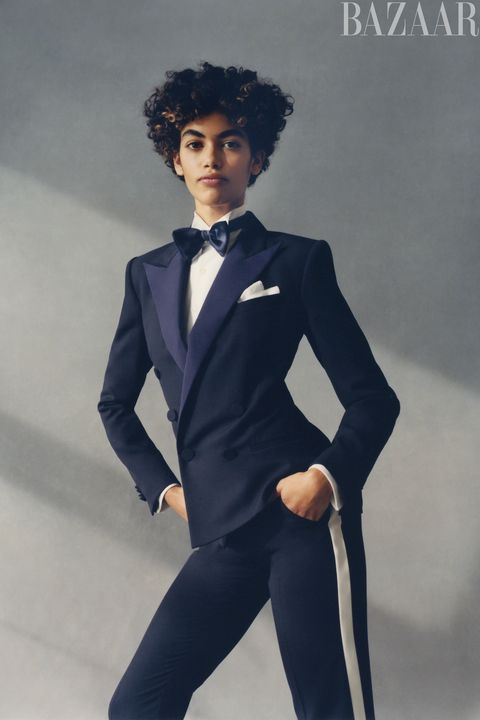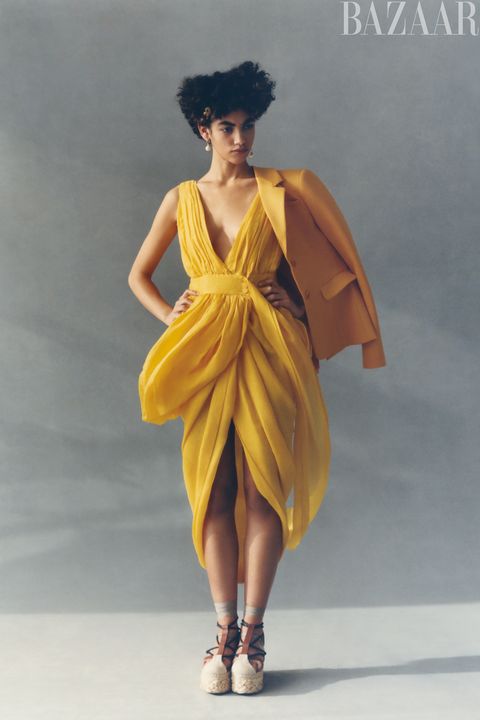American Sportswear Designers on What’s Next for Fashion
When Peter Do won a 2020 LVMH Prize, an award given by the French luxuury conglomerate to promising emerging fashion designers, it marked the first time a recipient’s designs carried a “Made in New York” label. Do, who was born in Vietnam and moved to Philadelphia as a teenager, launched his namesake line three years ago with the goal of building a new American luxury house, and spurring a renaissance in Manhattan’s Garment District, for decades the city’s manufacturing hub, but in more recent years a flagging emblem of an industry in transition. “We put pockets on everything,” Do says, explaining one of the more practical ways in which his line has tapped into American sportswear’s can-do legacy. “To me, American style epitomizes functionality.”
Once a bustling epicenter, the stretch of Seventh Avenue between 34th and 42nd streets has served as birthplace and home to some of American fashion’s greatest entrepreneurial success stories—designers such as Bonnie Cashin, Geoffrey Beene, Donna Karan, and Tommy Hilfiger, who all built thriving brands around their distinct visions. In the earlier part of the 20th century, the garment industry was New York’s biggest business; the street signs are still emblazoned with the words “Fashion Avenue.” Yet even before the current global health crisis, the American fashion industry was already wrestling with a laundry list of existential threats, including the unrelenting migration of manufacturing jobs and operations out of the city and overseas, as both established players and independent upstarts have had to make cuts in order to compete in an increasingly global economy.
When stay-at-home orders took effect in the early days of the pandemic, Do says, it was a priority for him to find ways to support his local network of production partners, many of them staffed and run by first-generation immigrants. He was able to press ahead with a Spring 2021 collection with some help from the post office. “We shipped fabric to our patternmakers’ apartments in Flushing,” Do recalls. “They would then drop it off to the seamstresses, who would ship it back to me in Brooklyn for the final fitting. It’s an American manufacturing story during Covid.” Do’s ethos is emblematic of the kind of drive, hustle, and mobility that has always animated American fashion, a business where the pursuit of the American dream leaves no room for clothes that slow you down. It’s a sensibility that in recent years has even begun to crop up in the European collections, where many of the hallmarks of American sportswear—the pragmatism, the separates, the streetwear-inspired playfulness—have filtered onto the runways of some of the most hallowed maisons.
The American sportswear tradition is rooted in the American immigrant experience. Indeed, its story begins in the 1920s with one Hattie Carnegie, born Henrietta Kanengeiser to a Jewish family in Vienna, who took her last name as a nod to American industrialist Andrew Carnegie and went from working as a shopgirl at Macy’s to founding her own multimillion-dollar fashion brand. Her signature “little Carnegie suit”—the LBD of tailoring—featured a nipped-waist jacket and coordinating skirt. If Parisian couture built on corsets and crinolines reflected the rarefied lifestyles of Europe’s aristocracy, Carnegie’s flattering and unfussy ready-to-wear was a revelation: clothes that allowed a range of motion beyond sitting pretty in a salon, and were made by and for people from everywhere, for everyone.
Claire McCardell, who worked for Carnegie at one point, is the designer most often credited for defining the “American look” in the 1940s and 1950s through her cotton and denim creations, which were democratic in both form and price. McCardell’s best-known pieces, such as the Monastic dress (a tent dress with a removable belt) and the Pop-over wrap dress, were mass-produced and designed to appeal to women of all body types and budgets.
But it wasn’t until the landmark Battle of Versailles fashion show in 1973, which pitted five American talents—Halston, Oscar de la Renta, Stephen Burrows, Anne Klein, and Bill Blass—against the designers of the French establishment that the fashion world truly had to concede that American fashion had earned its place. Showing clothes built for movement on a diverse cast that included many Black models, who danced down the runway instead of walking stiffly with numbered cards as was the European tradition, they helped cement New York’s place as a global fashion capital.
The Versailles show ushered in a golden age of American sportswear that saw the rise of powerhouses such as Donna Karan, Calvin Klein, Perry Ellis, and Ralph Lauren. While European fashion often communicated codes, traditions, and ideas designed to affirm certain attitudes about class and identity, American fashion offered a way to break free from those strictures—to mix items from different labels and periods, to combine streetwear and high-end pieces, and to use clothes as a tool for self-invention and even reinvention.
“American sportswear is about living,” says Ralph Lauren—born Ralph Lifshitz in the Bronx to Jewish immigrants from Belarus—who helped transform the U.S. fashion business into a global force by conjuring a cinematic world of preppy staples from polos and crewneck sweaters to relaxed tailoring that anyone can buy into. “It’s about comfort and ease, and having the confidence to experiment and enjoy the playfulness of clothes,” Lauren continues. “In America, style has always been about blending the dream with reality. It’s that contradiction that makes it so unexpected and optimistic.”
“Sportswear is a genuine American invention founded on women gaining more freedom at work, home, and in society,” says Tory Burch. “A kind of chic, reductive quality as well as an urbane practicality comes to mind when thinking of American fashion throughout the years,” says Proenza Schouler’s Jack McCollough. “It seems to have developed as a response to women’s real-world needs, and in our opinion the best American fashion continues to do so,” adds co-designer Lazaro Hernandez.
The white blouses in Carolina Herrera creative director Wes Gordon’s spring collection are an homage to the personal uniform of Herrera herself, an immigrant from Venezuela; in Gordon’s interpretation they are worn with miniskirts and tailored shorts. “She is a mother of four who started the business and needed a wardrobe that would make her look and feel brilliant, but without costing her the ability to efficiently get through her day,” Gordon says of Herrera. Similar thinking drove New York designer Maria Cornejo, who was born in Chile and grew up in England, to build her cult label around her signature asymmetrical dresses and avant-garde sweatshirting. “When I first moved here, I had a six-year-old and I was having another baby,” Cornejo recalls. “I wanted clothes that were real but also interesting, in fabrics that I could wash and wear.”
“American sportswear is about making sure that the end use is really fashion with a small ‘f,’not fashion with a capital ‘F,’ ” says Adam Lippes. Which isn’t to say that American sportswear is devoid of glamour. Christopher John Rogers, the 2020 CFDA American Emerging Designer of the Year, draws on the idea of “Sunday best,” imprinted on him as a child growing up in the Black Southern Baptist church. His collections are color drenched, and this season he brought a lightness to his signature architectural gowns with cotton fabrics. Rogers also designed the purple ensemble that Vice President Kamala Harris wore to the inauguration. “I think anything that feels like any member of your family could comfortably move through the world in is really what American sportswear is,” he says.
“The Valhalla of American fashion for me is forever Halston,” says Michael Kors, referring to the mononymous designer, born Roy Halston Frowick in Iowa, whose sleek designs in matte jersey became the unofficial Studio 54 uniform in the 1970s and fundamentally transformed eveningwear. Halston is also who inspired Brandon Maxwell, as a boy growing up in small-town Texas, to make a go of it in fashion. “I discovered Halston in a Polaroid shown to me by my fourth-grade art teacher, who was teaching the class about Warhol,” Maxwell says. “I thought these were some of the most glamorous people I’d ever seen in my life. They came to New York from Middle America to become the best versions of themselves. And it seemed so exciting and enticing.”
For Joseph Altuzarra, who was raised in Paris and is of French Basque and Chinese American heritage, American sportswear has become synonymous with inclusivity. “The next step after being pragmatic is actually being engaged with the world at large,” he says. “That association is something that I am very proud to be a part of.” Taiwan-born designer Jason Wu agrees: “American designers deserve a lot of credit for championing diversity in fashion and breaking the mold of traditional beauty.”
Representation and accessibility have become core to the missions of a new wave of American labels such as Telfar, Eckhaus Latta, and No Sesso, which have made it a priority to put models of all gender identities, body types, and ages on the runway. “We want our clothing to make you feel the most like you,” says Eckhaus Latta co-designer Mike Eckhaus.
“It is this entrepreneurial spirit and the diversity of our team, people from all over the world, that is American fashion and what makes it special,” says Gabriela Hearst, who was born in Uruguay. “It brings different perspectives to one common goal.” In many ways, American fashion is about a sense of community, an ingenuity, and a freedom—qualities that have allowed generations of designers to marshal the full weight of their creativity and resourcefulness to meet a range of challenges and moments. “Marc Jacobs taught me to be irreverent,” says Apotts designer Aaron Potts, a true veteran of the Seventh Avenue trenches, who got his start working on Jacobs’s infamous 1993 grunge collection for Perry Ellis and made his New York Fashion Week debut last year after nearly three decades working behind the scenes at brands like DKNY and Anne Klein. Subverting notions of race and identity, the voluminous, gender-fluid silhouettes in his spring collection—including couture-like ball skirts made of airy gingham and transformer pants that can be worn inside out to reveal a leopard pattern—take their cue from antique topsy-turvy dolls, half-Black, half-white conjoined rag dolls with a skirt that flips over to conceal one body when the other is upright. “You have to take what feels normal and turn it inside out,” says Potts. “Reimagine it, rethink it, and do it in a way that people haven’t seen before, or that shakes people up, just wakes them up.” And what, really, is more American than that?
Model: Vanessa Aguasvivas; Hair: Gonn Kinoshita for Amika; Makeup: Asami Matsuda for Chanel Beauty; Manicure: Michina Koide for Chanel Beauty.
GET THE LATEST ISSUE OF BAZAAR









